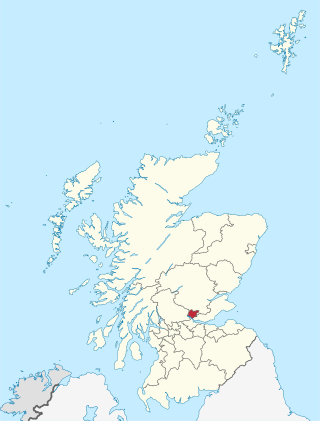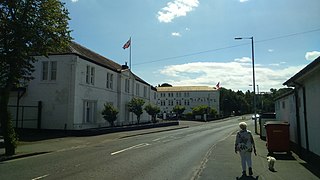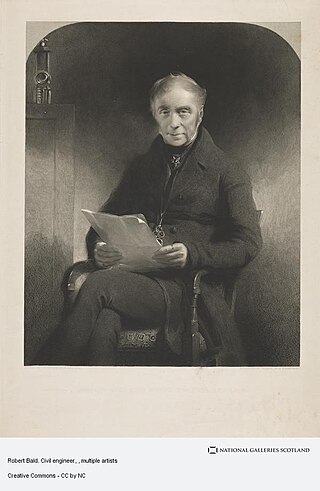
Clackmannanshire, or the County of Clackmannan, is a historic county, council area, registration county and lieutenancy area in Scotland, bordering the council areas of Stirling, Fife, and Perth and Kinross. In terms of historic counties it borders Perthshire, Stirlingshire and Fife.

Alloa is a town in Clackmannanshire in the Central Lowlands of Scotland. It is on the north bank of the Forth at the spot where some say it ceases to be the River Forth and becomes the Firth of Forth. Alloa is south of the Ochil Hills, 5.5 miles (8.9 km) east of Stirling and 7.9 miles (12.7 km) north of Falkirk; by water Alloa is 25 miles (40 km) from Granton.

Tillicoultry is a town in Clackmannanshire, Scotland. Tillicoultry is usually referred to as Tilly by the locals.

Alva is a small town in Clackmannanshire, set in the Central Lowlands of Scotland. It is one of a number of towns situated immediately to the south of the Ochil Hills, collectively referred to as the Hillfoots Villages or simply The Hillfoots. It is located between Tillicoultry and Menstrie. Alva had a resident population of 5,181 at the 2001 census but this has since been revised to 4,600 in 2016. It boasts many features such as a park with an event hall and a newly opened outdoor gym, and is the home of Alva Academy.
The Upper Hirst is a coal seam in central Scotland that was mined on a large scale in the 1950s through to 2002, mainly to supply Kincardine Power Station, and later, Longannet Power Station, in Fife.

The River Devon is a tributary of the River Forth in Clackmannanshire and Perth & Kinross, Scotland.

Harviestoun is an estate in Tillicoultry parish, Clackmannanshire, central Scotland. It lies at the base of the Ochil Hills, around 1.5 kilometres (0.93 mi) east of Tillicoultry and 2 kilometres (1.2 mi) west of Dollar.
Muckhart commonly refers to two small villages in Clackmannanshire, Scotland, Pool of Muckhart and Yetts o' Muckhart. Muckhart is one of the Hillfoots Villages, situated on the A91 around 3 miles northeast of Dollar. The Gaelic name, Muc-àird, comes from muc ("pig") + àird ("height"), and may derive from the fact that the surrounding fields may once have been used for pig farming.

Alloa railway station is a railway station in the town of Alloa, Clackmannanshire, Scotland, which was re-opened on Monday, 19 May 2008.

The Stirling and Dunfermline Railway was a railway in Scotland connecting Stirling and Dunfermline. It was planned by the Edinburgh and Glasgow Railway to get access to the mineral deposits on the line of route, but also as a tactical measure to keep the rival Caledonian Railway out of Fife.
The Alloa Railway was intended to bridge the River Forth linking Alloa with the south without using a ferry.

Robert Bald FRSE FSA MWS (1776–1861) was a Scottish surveyor, civil and mining engineer, and antiquarian. Robert Bald was one of the earliest and most eminent mining engineers and land surveyors in Scotland, and by the late nineteenth century he was referred to as "the acknowledged father of mining engineering in Scotland".
The Alloa Waggonway, also known as the Alloa Railway was an early tramway. It was 2+1⁄2 miles (4 km) miles long and connected coal pits above Alloa with the harbour and a bottle manufacturer at Alloa in Clackmannanshire, Scotland. The track was wooden with an iron running surface, and wagons were drawn by horses.
The Astley and Tyldesley Collieries Company formed in 1900 owned coal mines on the Lancashire Coalfield south of the railway in Astley and Tyldesley, then in the historic county of Lancashire, England. The company became part of Manchester Collieries in 1929 and some of its collieries were nationalised in 1947.
Strathdevon is the strath of the River Devon in Clackmannanshire, Scotland. Strathdevon is associated with the parish of Muckhart and was up until 1971 the southernmost tip of Perthshire.

The Black Devon is a river in Scotland. It rises in the Cleish Hills, specifically the area known as Outh Muir, 1.5 kilometres (0.93 mi) north of Knockhill Racing Circuit, around 9 kilometres (5.6 mi) north-west of Dunfermline, Fife, with the gathering of three small streams in branch formation. The river flows westwards through Balgonar, north of Saline, and then merges with the Saline Burn. The Black Devon flows into Clackmannanshire, through the hamlet of Forestmill and past the town of Clackmannan. The Black Devon enters the River Forth south of Alloa, 1 kilometre (0.62 mi) north of Dunmore Pier.

The Devon Valley Railway linked Alloa and Kinross in central Scotland, along a route following the valley of the River Devon. Its construction took 20 years from the first section opening in 1851, to the final section in 1871. Three railway companies were involved, and it encountered a great many problems both with finance and engineering.
The Railways of Kinross were a local network of three rural railways which made the town of Kinross in Scotland their objective in the 1850s.
Tillicoultry railway station served the town of Tillicoultry, Clackmannanshire, Scotland from 1851 to 1964 on the Devon Valley Railway and the Stirling and Dunfermline Railway.
John Melvin (1855–1905) was a Scottish architect in central Scotland specialising in Arts & Crafts architecture.











